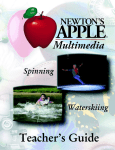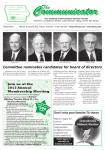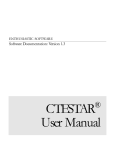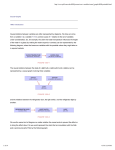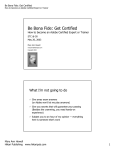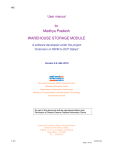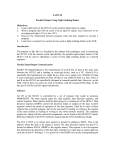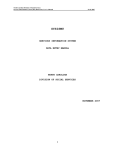Download Foundations of Physics I
Transcript
Foundations of Physics I Fall 2003 Physics 191 PEngel 173 Instructor: Lab: Name: Dr. Tom Kirkman Phone: 363–3811 Office: PEngel 111 Office Hour: 11:00 a.m. Day 4 email: [email protected] You must be registered in one of the lab sections required for this course. Labs meet most (but not all) cycles on Days 4–6 for three hours. Time in lab is limited so prepare for each lab by reading the lab manual before lab. Pre-lab exercises and short pre-lab quizzes must be turned in at the beginning of lab. Your completed lab report must be turned in at the end of the lab. You will need to purchase three lab notebooks with quad ruled paper (so they can be used for graphs) and a sewn binding (e.g., Ampad #26–251). Read the introduction to the Laboratory Manual ASAP for further information on the lab. Texts: • Fundamentals of Physics by David Halliday, Robert Resnick & Jearl Walker (Wiley, 2001 6th edition) Chapters: 1–14, 16 • Problem Supplement by Jearl Walker • Laboratory Manual for Foundations of Physics I • An Introduction to Error Analysis (recommended for lab) • http://www.physics.csbsju.edu/191/ Good lab skills are the key to success in science. Almost certainly your first job in science will not resemble an exam: with lots of pencil pushing on madeup problems; rather it will most resemble lab: where you use equipment to collect data on real—less than perfect—objects. If you enjoy lab, but struggle on exams, do not despair: there is plenty of demand for folks who can do and only a handful of scientists end up like Einstein working at a blackboard. Grading: Questions: Your grade will be determined by averaging seven scores: total quiz/homework score, total lab score, three exam scores, and the final exam score (which is double-counted). Assigned homework is due at the beginning of the next class period. Late homework is generally not accepted. The quizzes are 10 minute in-class exams on just completed material. Missed quizzes cannot be made up. The hour exams indlucde both multiple choice and numerical problems. You may use a single-sided 8 12 ” × 11” “formula sheet” to assist you on the exam. The formula sheet should be limited to formulas and definitions—no worked examples. Exam dates are: September 19 (Friday), October 17 (Friday), and November 14 (Friday). If informed in advance, I may be able to accommodate exam conflicts. The final exam will be comprehensive and have a structure similar to the other exams, but proportionally longer. The final exam has not yet been scheduled by the registrar. There is no such thing as a dumb question. Questions during lecture do not “interrupt” the lecture, rather they indicate your interests or misunderstandings. I’d much rather clear up a misunderstanding or discuss a topic of interest than continue a dull lecture. Remember: you are almost never alone in your interests, your misunderstandings, or your problems. Please help your classmates by asking any question vaguely related to physics. If you don’t want to ask your question during class, that’s fine too: I can be found almost any time in my office (EngelSC 111) or the nearby labs. Drop in any time! Topics: This course covers the discoveries of Isaac Newton (1642–1727) which are the foundation of the science and technology that transformed the animal powered world of Newton into the mechanized world of today. The basis for Newton’s discoveries was that the universe follows mathematical laws, so improvements to technology can be calculated rather than found by trial and error. This idea of a mathematical universe is ancient (e.g., often attributed to Pythagoras (ca. 585–497 b.c.)) so one might wonder why it didn’t happen much earlier: Why, for example, didn’t Archimedes (287–212 b.c.), often called the Newton of the ancient world, “scoop” Newton and discover the mathematical rules that govern the universe? Imagine: Joseph an auto mechanic rather than a carpenter. The key discovery that Newton made (and that Archimedes “almost” made) was the differential equation. Differential equations are probably a couple of years beyond your current mathematical studies (math 337: Differential Equations) but the idea is simple enough that I can explain it now. When you think of an equation you may be thinking of something like: y = a + bx which, as you learned in analytical geometry, describes a line when displayed as a graph of y vs. x for constant a (the y-intercept) and b (the slope): translates to the differential equation: d2 y =0 dx2 or y 00 = 0 Thus a differential equation is an equation that includes derivatives, i.e., changes. (A philosophical question: Why are the universe’s laws differential equations rather than some other sort of magic or mathematics?) A mathematics course in differential equations teaches you how to go from a differential equation, which tells you how things change, to an equation, which gives you the complete story. Science courses then explain which differential equations are used by nature. Remark: mathematics usually uses the generic variable names x and y, whereas in science we’re most commonly concerned with how things change in time. Thus the thing that in your math class is labeled x will most often in your science classes be labeled t. In this physics class, we’ll often be concerned with the position of objects which we’ll often label x. Thus to translate from your math class to your physics class: x → t and y → x. Thus a typical physics equation is: 1 x = x0 + v0 t + at2 2 y and a typical physics differential equation is: slope: b y intercept: a x Equations like this are particularly nice because if you know the numerical values of all the things on the right hand side (x, a, b) you can calculate the value of the thing on the left hand side (y). In some sense such an equation gives the relationship between x and y completely and immediately. For example, in the case of the ideal gas law: P V = nRT , if you know the numerical value of any four of the quantities you can calculate the fifth. What Newton discovered was that the fundamental laws of nature are not equations like the above. Instead of giving us the the whole story in one package (an equation) nature’s rules focus on change, reporting how things change with time or position. For example, one could equally well describe a straight line by saying it has unchanging slope which d2 x =a dt2 or x00 = a A major stumbling block should now be evident. The universe speaks in the language of differential equations and most of you are years away from taking the intro course in that language. Thus the process of translating from the fundamental laws of nature (like Newton’s three laws) to the immediately usable equations will sometimes seem mystifying, awkward and uninteresting. One might make the mistake of trying to “learn physics” by memorizing dozens of equations rather than understanding the fundamental differential equations that apply to any possible situation. “Give a man a fish, and you feed him for a day; teach a man to fish, and you get rid of him on weekends.” This course will focus on applying Newton’s laws of motion to four situations: (A) motion with a constant applied force, (B) motion in a circle at constant speed, (C) oscillatory motion and (D) orbital motion (the space shuttle orbiting the Earth or the Earth orbiting the Sun). Clearly these four situations are a small subset of real life motions. Please realize that Newton’s laws explain equally easily all real-life motions, but we need the methods taught in a differential equations class to apply them to more complicated situations. Implicit in the concept “motion” is the idea of change. Nevertheless, physics has discovered quantities that stay constant even as most every common-sense quantity associated with a motion varies. These quantities that stay constant—called conserved quantities— provide simple ways of understanding motions. In this course we will be particularly interested in the conservation of (A) energy, (B) linear momentum, and (C) angular momentum. (An analogy: when a log burns initially we have wood and oxygen and finally we have hot gases and ash. Everything seems changed. Nevertheless you’ve learned that the number of carbon atoms stayed constant during the reaction. In chemistry the conservation of atoms during chemical reactions is a great unifying principle.) There are a couple of aspects of this course that make it particularly difficult. First, things do not work the way common sense tells you: often you’ll find your intuition misleading you. You step on the car’s accelerator and you’re pushed back in the seat; commonsense says the cause is “inertia”. You round a corner and the books that were sitting on the car seat are thrown to the side; common sense says the cause is “centrifugal force”. In this course you will learn that “centrifugal force” and “inertia” play no role in the true explanation of motion. I know it is impossible for you to throw out the understanding of how the world works that you’ve developed over your lifetime and substitute the correct but weird and abstract laws of motion discovered by Newton. 42 hours of instruction can not overcome a lifetime of experience. About the most I can hope for is that in a few artificial examples you’ll know—but perhaps not believe—how to apply the true laws of motion. Think about it: you’ve spent a lifetime observing the universe and have come to wrong conclusions about how it works. (But those wrong conclusions are still useful to predict the behavior of your car. A follower of Bokononism would call your conclusions—and Newton’s—foma 1 .) You might now conclude that the human mind was not 1 Kurt Vonnegut, Jr created the religion of Bokononism in his book Cat’s Cradle. Foma are the useful lies of that madeup religion. Vonnegut actually knows something about how the universe works. He wrote that “freshman physics is invariably the most satisfying course offered by any American university.” built to comprehend the true causes of the universe. But the actual result is far stranger than that. First the famous Einstein quote: “The most incomprehensible thing about the universe is that it is comprehensible.” Now the true causes of the universe are not yet totally known, and it is quite possible that when/if discovered they will be understandable only to a few thousand physicists. What we already know is that the road to comprehending the universe has been a series of steps. Common sense ideas of how the world works were written down by Aristotle (384–322 b.c.) replacing unwritten ideas that served mankind for the previous million years. Aristotle’s physics was good enough to build cathedrals and catapults and is probably accurate enough for the vast majority of people who do not need understand how their car works let alone design a car engine. Newton’s “F = ma” is a tremendous leap forward in understanding, explaining 99% of everyday experience, but it is not the last word. Electrodynamics, statistical mechanics, quantum mechanics, relativity, relativistic quantum field theory. . . , each step forward has been based on the previous steps, in such a way that each advancement seems impossible without the previous steps. (I cannot imagine how quantum mechanics could have been discovered unless Newtonian mechanics had been discovered first.) Thus our growing comprehension as to how the world works has been structured like learning from a good user’s manual: the most useful stuff comes first and then each further refinement is explained. While the universe might not be comprehensible in one gulp, it seems there is a step-by-step approach you can follow to understand it. Your interests and abilities will determine how much of the universe you care to understand, but expect “common sense” to fight every step forward. Second, since the universe follows mathematical laws, in order to understand the universe you must be able to do mathematics. In this course we will use 110% of the mathematics you’ve learned over your lifetime: arithmetic, geometry, trigonometry, algebra, and calculus. Trying to recall the mathematics you learned a couple of years ago and apply it in new situations is challenging. The best tonics for this problem are to ask lots of questions and work lots of problems. (Yes, work problems that are not assigned.) In addition carefully study the “Problem Solving Tactics” listed on the inside back cover to our book and read the advice recorded on the class web page. Schedule Day 1/1 1/3 1/5 2/1 2/3 2/5 3/1 3/3 3/5 4/1 4/3 4/5 5/1 5/3 5/5 6/1 6/3 6/5 7/1 7/3 7/5 8/1 8/3 8/5 9/1 9/3 9/5 10/1 10/3 10/5 11/1 W F W F T R M W F T R M W F T M W F T R M W F T R M W F T R M Date Aug 27 Aug 29 Sep 3 Sep 5 Sep 9 Sep 11 Sep 15 Sep 17 Sep 19 Sep 23 Sep 25 Sep 29 Oct 1 Oct 3 Oct 7 Oct 13 Oct 15 Oct 17 Oct 21 Oct 23 Oct 27 Oct 29 Oct 31 Nov 4 Nov 6 Nov 10 Nov 12 Nov 14 Nov 18 Nov 20 Nov 24 Text 1.1–1.6 2.1–2.4 2.5–2.8 3.1–3.7 4.1–4.4 4.5–4.6 4.7–4.9 1.1–4.9 1.1–4.9 5.1–5.7 5.8 6.1–6.3 6.4 7.1–7.7 8.1–8.4 8.4–8.7 8.4–8.7 5.1–8.7 9.1–9.5 9.4–9.7 10.1–10.5 10.6 11.1–11.5 11.6–11.7 11.7–11.10 12.1–12.9 9.1–12.9 12.6–12.10 13.1–13.4 13.5–13.6 Topics Measurements Position, Velocity Acceleration, Gravity Vectors Vector Calculus, Motion Projectile Motion Circular & Relative Motion Review Math & Motion Newton’s Laws Applying Newton’s Laws Friction Circular Motion K.E. & Work Potential Energy Conservation of Energy Conservation of Energy Force & Energy Systems of Particles Momentum Collisions 2-Dimensional Collisions Rotational Motion Rotational Inertia Rotational Dynamics Rolling, Torque Problems Collisions & Rotations Angular Momentum Statics Stress/Strain Exams Labs (Days: 4–6) Data Analysis Quiz 1 Free Fall Quiz 2 Exam 1 Projectile Motion Quiz 3 Atwood Machine Quiz 4 Kinetic Friction Quiz 5 Quiz 6 Exam 2 Quiz 7 Ballistic Pendulum Quiz 8 Two-body Collisions Quiz 9 Exam 3 Rotational Dynamics Quiz 10 Thanksgiving Break: Wednesday–Friday 11/3 11/5 12/1 12/3 12/5 M W F T R Dec Dec Dec Dec Dec 1 3 5 9 11 14.1–14.6 14.6–14.9 16.1–16.4 16.5–16.9 1–14, 16 1–14, 16 Gravitation P.E. & Orbits Oscillations Harmonic Oscillators Review Everything! Quiz 11 Simple Harmonic Motion Final Exam





